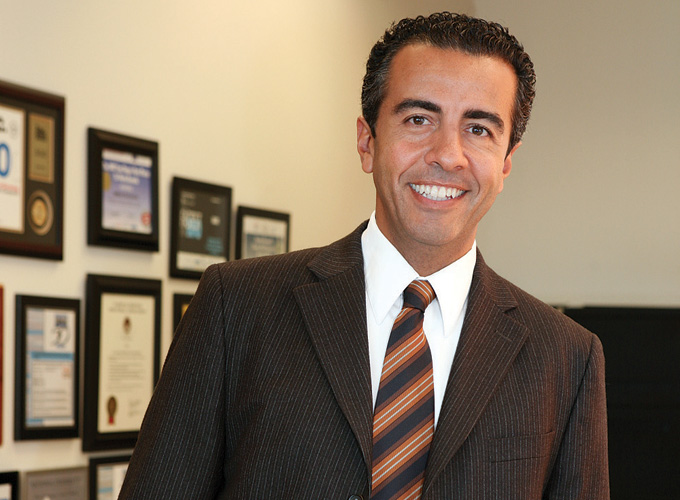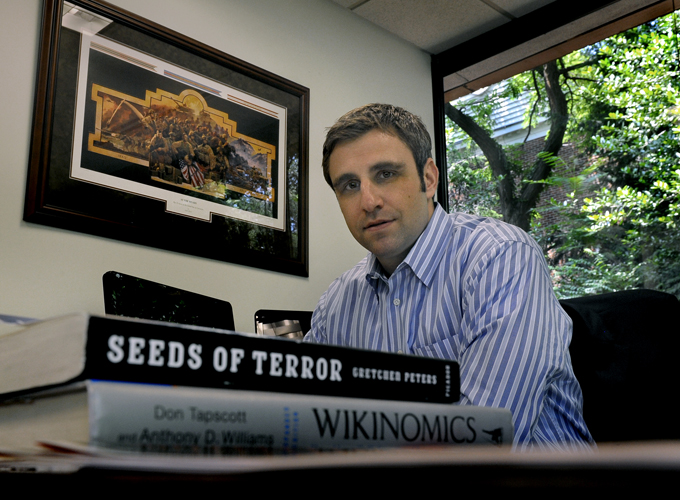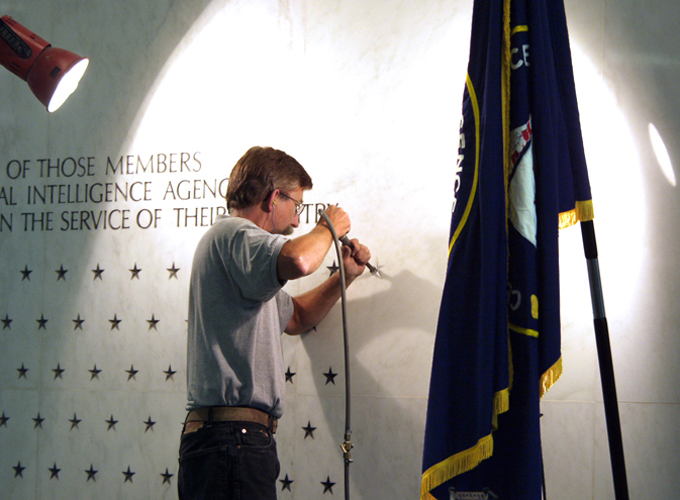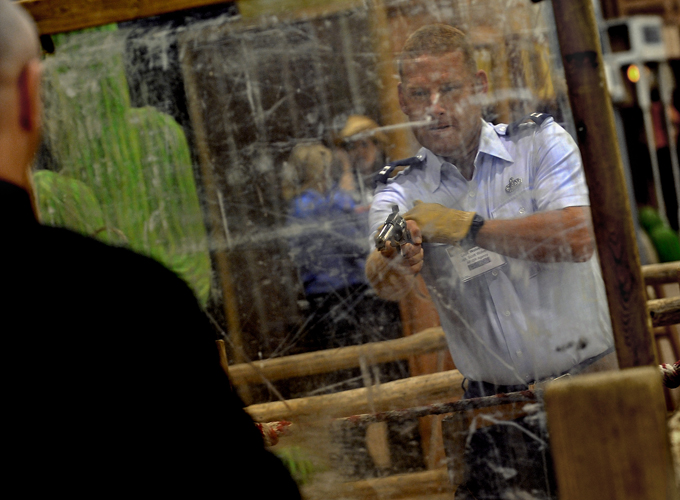Washington
Post
Top Secret
America
(part 2 of 3) July
20, 2010
National Security Inc.
by Dana Priest and William M. Arkin
(To go to the Washington Post web page with these three articles, and
related slide shows, videos, and articles
click here -- or if that comes up small print go to :
http://projects.washingtonpost.com/top-secret-america/ or Google Wash Post,
Top Secret America.)
| |
ClearanceJobs.com offers patriotic mints in its
booth advertising the company's services placing defense workers. About
265,000 U.S. contractors have top-level clearance. (Photo by Michael
S. Williamson / The Washington Post) |
|
 |
|
|
| |
|
|
|
|
|
| |
|
|
|
|
|
In June, a stone carver from Manassas
chiseled another perfect star into a marble wall at
CIA headquarters, one of 22 for agency
workers killed in the global war initiated by the 2001 terrorist attacks.
The intent of the memorial is to publicly honor the courage of those who died
in the line of duty, but it also conceals a deeper story about government in the
post-9/11 era: Eight of the 22 were not CIA officers at all. They were private
contractors.
To ensure that the country's most sensitive duties are carried out only by
people loyal above all to the nation's interest, federal rules say contractors
may not perform what are called "inherently government functions." But they do,
all the time and in every intelligence and counterterrorism agency, according to
a two-year investigation by The Washington Post.
What started as a temporary fix in response to the terrorist attacks has
turned into a dependency that calls into question whether the federal workforce
includes too many people obligated to shareholders rather than the public
interest -- and whether the government is still in control of its most sensitive
activities. In interviews last week, both Defense Secretary Robert M. Gates and
CIA Director Leon Panetta said they agreed with such concerns.
The Post investigation uncovered what amounts to an alternative geography of
the United States,
a Top Secret America created since 9/11 that is hidden from public view, lacking
in thorough oversight and so unwieldy that its effectiveness is impossible to
determine.
It is also a system in which contractors are playing an ever more important
role. The Post estimates that out of 854,000 people with top-secret clearances,
265,000 are contractors. There is no better example of the government's
dependency on them than at the CIA, the one place in government that exists to
do things overseas that no other U.S.
agency is allowed to do.
Private contractors working for the CIA have recruited spies in
Iraq, paid bribes for information in
Afghanistan
and protected CIA directors visiting world capitals. Contractors have helped
snatch a suspected extremist off the streets of
Italy, interrogated detainees once held at
secret prisons abroad and watched over defectors holed up in the
Washington
suburbs. At Langley headquarters,
they analyze terrorist networks. At the agency's training facility in
Virginia, they are helping mold a new generation of
American spies.
Through the federal budget process, the George W. Bush administration and
Congress made it much easier for the CIA and
other agencies involved in counterterrorism to hire more contractors than civil
servants. They did this to limit the size of the permanent workforce, to hire
employees more quickly than the sluggish federal process allows and because they
thought - wrongly, it turned out - that contractors would be less expensive.
Nine years later, well into the Obama administration, the idea that
contractors cost less has been repudiated, and the administration has made some
progress toward its goal of reducing the number of hired hands by 7 percent over
two years. Still, close to 30 percent of the workforce in the intelligence
agencies is contractors.
"For too long, we've depended on contractors to do the operational work that
ought to be done" by CIA employees, Panetta said. But replacing them "doesn't
happen overnight. When you've been dependent on contractors for so long, you
have to build that expertise over time."
A second concern of Panetta's: contracting with corporations, whose
responsibility "is to their shareholders, and that does present an inherent
conflict."
Or as Gates, who has been in and out of government his entire life, puts it:
"You want somebody who's really in it for a career because they're passionate
about it and because they care about the country and not just because of the
money."
Contractors can offer more money - often twice as much - to experienced
federal employees than the government is allowed to pay them. And because
competition among firms for people with security clearances is so great,
corporations offer such perks as BMWs and $15,000 signing bonuses, as Raytheon
did in June for software developers with top-level clearances.
The idea that the government would save money on a contract workforce "is a
false economy," said Mark M. Lowenthal, a former senior CIA official and now
president of his own intelligence training academy.
As companies raid federal agencies of talent, the government has been left
with the youngest intelligence staffs ever while more experienced employees move
into the private sector. This is true at the CIA, where employees from 114 firms
account for roughly a third of the workforce, or about 10,000 positions. Many of
them are temporary hires, often former military or intelligence agency employees
who left government service to work less and earn more while drawing a federal
pension.
Across the government, such workers are used in every conceivable way.
Contractors kill enemy fighters. They spy on foreign governments and
eavesdrop on terrorist networks. They help craft war plans. They gather
information on local factions in war zones. They are the historians, the
architects, the recruiters in the nation's most secretive agencies. They staff
watch centers across the Washington
area. They are among the most trusted advisers to the four-star generals leading
the nation's wars.
So great is the government's appetite for private contractors with top-secret
clearances that there are now more than 300 companies, often nicknamed "body
shops," that specialize in finding candidates, often for a fee that approaches
$50,000 a person, according to those in the business.
Making it more difficult to replace contractors with federal employees: The
government doesn't know how many are on the federal payroll. Gates said he wants
to reduce the number of defense contractors by about 13 percent, to pre-9/11
levels, but he's having a hard time even getting a basic head count.
"This is a terrible confession," he said. "I can't get a number on how many
contractors work for the Office of the Secretary of Defense," referring to the
department's civilian leadership.

As Top Secret America has grown, the government has become
more dependent on contractors with matching security clearances.
Launch Photo Gallery »
The Post's estimate of 265,000 contractors doing top-secret work was vetted
by several high-ranking intelligence officials who approved of The Post's
methodology. The newspaper's Top Secret America database includes
1,931 companies that perform work at the
top-secret level. More than a quarter of them - 533 - came into being after
2001, and others that already existed have expanded greatly. Most are thriving
even as the rest of the United States
struggles with bankruptcies, unemployment and foreclosures.
The privatization of national security work has been made possible by a
nine-year "gusher" of money, as Gates recently described national security
spending since the 9/11 attacks.
With so much money to spend, managers do not always worry about whether they
are spending it effectively.
"Someone says, 'Let's do another study,' and because no one shares
information, everyone does their own study," said Elena Mastors, who headed a
team studying the al-Qaeda leadership for the
Defense Department. "It's about how many
studies you can orchestrate, how many people you can fly all over the place.
Everybody's just on a spending spree. We don't need all these people doing all
this stuff."
Most of these contractors do work that is fundamental to an agency's core
mission. As a result, the government has become dependent on them in a way few
could have foreseen: wartime temps who have become a permanent cadre.
Just last week, typing "top secret" into the search engine of a major jobs
Web site showed 1,951 unfilled positions in the Washington area, and 19,759
nationwide: "Target analyst," Reston. "Critical infrastructure specialist,"
Washington, D.C.
"Joint expeditionary team member," Arlington.
"We could not perform our mission without them. They serve as our 'reserves,'
providing flexibility and expertise we can't acquire," said Ronald Sanders, who
was chief of human capital for the Office of the Director of National
Intelligence before retiring in February. "Once they are on board, we treat them
as if they're a part of the total force."
The Post's investigation is based on government documents and contracts, job
descriptions, property records, corporate and social networking Web sites,
additional records, and hundreds of interviews with intelligence, military and
corporate officials and former officials. Most requested anonymity either
because they are prohibited from speaking publicly or because, they said, they
feared retaliation at work for describing their concerns.
The investigation focused on top-secret work because the amount classified at
the secret level is too large to accurately track. A
searchable database of government
organizations and private companies was built entirely on public records. [For
an explanation of the newspaper's decision making behind this project, please
see the
Editor's Note.]
----
The national security industry sells the military and intelligence agencies
more than just airplanes, ships and tanks. It sells contractors' brain power.
They advise, brief and work everywhere, including 25 feet under the Pentagon in
a bunker where they can be found alongside military personnel in battle fatigues
monitoring potential crises worldwide.
Late at night, when the wide corridors of the Pentagon are all but empty, the
National Military
Command Center
hums with purpose. There's real-time access to the location of
U.S.
forces anywhere in the world, to granular satellite images or to the
White House Situation Room.
The purpose of all this is to be able to answer any question the chairman of
the
Joint Chiefs of Staff might have. To be
ready 24 hours a day, every day, takes five brigadier generals, a staff of
colonels and senior noncommissioned officers - and a man wearing a pink
contractor badge and a bright purple shirt and tie.
Erik Saar's job title is "knowledge engineer." In one of the most sensitive
places in America,
he is the only person in the room who knows how to bring data from far afield,
fast. Saar and four teammates from a private company,
SRA International, teach these top-ranked
staff officers to think in Web 2.0. They are trying to push a tradition-bound
culture to act differently, digitally.

Recruiters for companies that hold government contracts
meet with job seekers who have security clearances at a Targeted Job Fairs event
in McLean,
Va.
Launch Video »
That sometimes means asking for help in a public online chat room or
exchanging ideas on shared Web pages outside the military computer networks
dubbed .mil - things much resisted within the Pentagon's self-sufficient
culture. "Our job is to change the perception of leaders who might drive
change," Saar said.
Since 9/11, contractors have made extraordinary contributions - and
extraordinary blunders - that have changed history and clouded the public's view
of the distinction between the actions of officers sworn on behalf of the
United States and corporate employees with
little more than a security badge and a gun.
Contractor misdeeds in Iraq
and Afghanistan
have hurt U.S.
credibility in those countries as well as in the Middle East.
Abuse of prisoners at Abu Ghraib, some of it done by contractors, helped ignite
a call for vengeance against the United States
that continues today. Security guards working for
Blackwater added fuel to the five-year
violent chaos in Iraq
and became the symbol of an America
run amok.
line between the legitimate and illegitimate use of force, which is just what
our enemies want," Allison Stanger, a professor of international politics and
economics at Middlebury College and the author of "One Nation Under Contract,"
told the independent Commission on Wartime Contracting at a hearing in June.
Misconduct happens, too. A defense contractor formerly called
MZM paid bribes for CIA contracts, sending
Randy "Duke" Cunningham, who was a California
congressman on the intelligence committee, to prison. Guards employed in
Afghanistan
by ArmorGroup North America, a private security company, were caught on camera
in a lewd-partying scandal.
But contractors have also advanced the way the military fights. During the
bloodiest months in Iraq,
the founder of Berico Technologies, a former Army officer named Guy Filippelli,
working with the
National Security Agency, invented a
technology that made finding the makers of roadside bombs easier and helped
stanch the number of casualties from improvised explosives, according to NSA
officials.
Contractors have produced blueprints and equipment for the unmanned aerial
war fought by drones, which have killed the largest number of senior al-Qaeda
leaders and produced a flood of surveillance videos. A dozen firms created the
transnational digital highway that carries the drones' real-time data on
terrorist hide-outs from overseas to command posts throughout the
United States.
Private firms have become so thoroughly entwined with the government's most
sensitive activities that without them important military and intelligence
missions would have to cease or would be jeopardized. Some examples:
*At the
Department of Homeland Security (DHS), the
number of contractors equals the number of federal employees. The department
depends on 318 companies for essential services and personnel, including 19
staffing firms that help DHS find and hire even more contractors. At the office
that handles intelligence, six out of 10 employees are from private industry.
surveillance, hires private firms to come up with most of its technological
innovations. The NSA used to work with a small stable of firms; now it works
with at least 484 and is actively recruiting more.
*The
National Reconnaissance Office cannot
produce, launch or maintain its large satellite surveillance systems, which
photograph countries such as China,
North Korea and
Iran, without
the four major contractors it works with.
*Every intelligence and military organization depends on contract linguists
to communicate overseas, translate documents and make sense of electronic voice
intercepts. The demand for native speakers is so great, and the amount of money
the government is willing to pay for them is so huge, that 56 firms compete for
this business.
*Each of the 16 intelligence agencies depends on corporations to set up its
computer networks, communicate with other agencies' networks, and fuse and mine
disparate bits of information that might indicate a terrorist plot. More than
400 companies work exclusively in this area, building classified hardware and
software systems.
Hiring contractors was supposed to save the government money. But that has
not turned out to be the case. A 2008 study published by the
Office of the Director of National Intelligence
found that contractors made up 29 percent of the workforce in the intelligence
agencies but cost the equivalent of 49 percent of their personnel budgets. Gates
said that federal workers cost the government 25 percent less than contractors.
The process of reducing the number of contractors has been slow, if the giant
Office of Naval Intelligence in
Suitland is any example. There, 2,770 people work on the
round-the-clock maritime watch floor tracking commercial vessels, or in science
and engineering laboratories, or in one of four separate intelligence centers.
But it is the employees of 70 information technology companies who keep the
place operating.
They store, process and analyze communications and intelligence transmitted
to and from the entire U.S.
naval fleet and commercial vessels worldwide. "Could we keep this building
running without contractors?" said the captain in charge of information
technology. "No, I don't think we could keep up with it."
Vice Adm. David J. "Jack" Dorsett, director of naval intelligence, said he
could save millions each year by converting 20 percent of the contractor jobs at
the Suitland complex to civil servant positions. He has
gotten the go-ahead, but it's been a slow start. This year, his staff has
converted one contractor job and eliminated another - out of 589. "It's costing
me an arm and a leg," Dorsett said.
----
Washington's corridors of power
stretch in a nearly straight geographical line from the Supreme Court to the
Capitol to the White House. Keep going west, across the Potomac River,
and the unofficial seats of power - the private, corporate ones - become
visible, especially at night. There in the Virginia
suburbs are the brightly illuminated company logos of Top Secret America:
Northrop Grumman,
SAIC,
General Dynamics.

Defense Secretary Robert M. Gates says he would like to
reduce the number of defense contractors to pre-9/11 levels. (Photo by: Melina
Mara | The Washington Post)
Of the 1,931 companies identified by The Post that work on top-secret
contracts, about 110 of them do roughly 90 percent of the work on the corporate
side of the defense-intelligence-corporate world.
To understand how these firms have come to dominate the post-9/11 era,
there's no better place to start than the Herndon office of General Dynamics.
One recent afternoon there, Ken Pohill was watching a series of unclassified
images, the first of which showed a white truck moving across his computer
monitor.
The truck was in Afghanistan,
and a video camera bolted to the belly of a U.S.
surveillance plane was following it. Pohill could access a dozen images that
might help an intelligence analyst figure out whether the truck driver was just
a truck driver or part of a network making roadside bombs to kill American
soldiers.
To do this, he clicked his computer mouse. Up popped a picture of the truck
driver's house, with notes about visitors. Another click. Up popped infrared
video of the vehicle. Click: Analysis of an object thrown from the driver's
side. Click: U-2 imagery. Click: A history of the truck's movement. Click. A
Google Earth map of friendly forces. Click: A chat box with everyone else
following the truck, too.
Ten years ago, if Pohill had worked for General Dynamics, he probably would
have had a job bending steel. Then, the company's center of gravity was the
industrial port city of Groton,
Conn., where men and women in wet galoshes churned out
submarines, the thoroughbreds of naval warfare. Today, the firm's commercial
core is made up of data tools such as the digital imagery library in Herndon and
the secure BlackBerry-like device used by President Obama, both developed at a
carpeted suburban office by employees in loafers and heels.
The evolution of General Dynamics was based on one simple strategy: Follow
the money.
The company embraced the emerging intelligence-driven style of warfare. It
developed small-target identification systems and equipment that could intercept
an insurgent's cellphone and laptop communications. It found ways to sort the
billions of data points collected by intelligence agencies into piles of
information that a single person could analyze.
It also began gobbling up smaller companies that could help it dominate the
new intelligence landscape, just as its competitors were doing. Between 2001 and
2010, the company acquired 11 firms specializing in satellites, signals and
geospatial intelligence, surveillance, reconnaissance, technology integration
and imagery.
On Sept. 11, 2001,
General Dynamics was working with nine intelligence organizations. Now it has
contracts with all 16. Its employees fill the halls of the NSA and DHS. The
corporation was paid hundreds of millions of dollars to set up and manage DHS's
new offices in 2003, including its National
Operations Center,
Office of Intelligence and Analysis and Office of Security. Its employees do
everything from deciding which threats to investigate to answering phones.
General Dynamics' bottom line reflects its successful transformation. It also
reflects how much the U.S. government - the firm's largest customer by far - has
paid the company beyond what it costs to do the work, which is, after all, the
goal of every profit-making corporation.
The company reported $31.9 billion in revenue in 2009, up from $10.4 billion
in 2000. Its workforce has more than doubled in that time, from 43,300 to 91,700
employees, according to the company.
Revenue from General Dynamics' intelligence- and information-related
divisions, where the majority of its top-secret work is done, climbed to $10
billion in the second quarter of 2009, up from $2.4 billion in 2000, accounting
for 34 percent of its overall revenue last year.
The company's profitability is on display in its Falls
Church headquarters. There's a soaring, art-filled lobby,
bistro meals served on china enameled with the General Dynamics logo and an
auditorium with seven rows of white leather-upholstered seats, each with its own
microphone and laptop docking station.
General Dynamics now has operations in every corner of the intelligence
world. It helps counterintelligence operators and trains new analysts. It has a
$600 million
Air Force contract to intercept
communications. It makes $1 billion a year keeping hackers out of
U.S.
computer networks and encrypting military communications. It even conducts
information operations, the murky military art of trying to persuade foreigners
to align their views with U.S.
interests.
"The American intelligence community is an important market for our company,"
said General Dynamics spokesman Kendell Pease. "Over time, we have tailored our
organization to deliver affordable, best-of-breed products and services to meet
those agencies' unique requirements."
In September 2009, General Dynamics won a $10 million contract from the
U.S. Special Operations Command's
psychological operations unit to create Web sites to influence foreigners' views
of U.S.
policy. To do that, the company hired writers, editors and designers to produce
a set of daily news sites tailored to five regions of the world. They appear as
regular news Web sites, with names such as "SETimes.com: The News and Views of
Southeast Europe." The first indication that they are run on behalf of the
military comes at the bottom of the home page with the word "Disclaimer." Only
by clicking on that do you learn that "the Southeast European Times (SET) is a
Web site sponsored by the United States European Command."
What all of these contracts add up to: This year, General Dynamics' overall
revenue was $7.8 billion in the first quarter, Jay L. Johnson, the company's
chief executive and president, said at an earnings conference call in April.
"We've hit the deck running in the first quarter," he said, "and we're on our
way to another successful year."
----
In the shadow of giants such as General Dynamics are 1,814 small to midsize
companies that do top-secret work. About a third of them were established after
Sept. 11, 2001, to take
advantage of the huge flow of taxpayer money into the private sector. Many are
led by former intelligence agency officials who know exactly whom to approach
for work.
Abraxas of Herndon, headed by a former CIA
spy, quickly became a major CIA contractor after 9/11. Its staff even recruited
midlevel managers during work hours from the CIA's cafeteria, former agency
officers recall.
Other small and medium-size firms sell niche technical expertise such as
engineering for low-orbit satellites or long-dwell sensors. But the vast
majority have not invented anything at all. Instead, they replicate what the
government's workforce already does.
A company called
SGIS, founded soon after the 2001 attacks,
was one of these.
In June 2002, from the spare bedroom of his San Diego
home, 30-year-old Hany Girgis put together an information technology team that
won its first Defense Department contract four months later. By the end of the
year, SGIS had opened a Tampa
office close to the
U.S. Central Command and Special Operations
Command, had turned a profit and had 30 employees.

Since Sept. 11,
2001, the top-secret world created to respond to the terrorist
attacks has grown into an unwieldy enterprise spread over 10,000
U.S.
locations.
Launch Photo Gallery »
SGIS sold the government the services of people with specialized skills;
expanding the types of teams it could put together was one key to its growth.
Eventually it offered engineers, analysts and cyber-security specialists for
military, space and intelligence agencies. By 2003, the company's revenue was
$3.7 million. By then, SGIS had become a subcontractor for General Dynamics,
working at the secret level. Satisfied with the partnership, General Dynamics
helped SGIS receive a top-secret facility clearance, which opened the doors to
more work.
By 2006, its revenue had multiplied tenfold, to $30.6 million, and the
company had hired employees who specialized in government contracting just to
help it win more contracts.
"We knew that's where we wanted to play," Girgis said in a phone interview.
"There's always going to be a need to protect the homeland."
Eight years after it began, SGIS was up to revenue of $101 million, 14
offices and 675 employees. Those with top-secret clearances worked for 11
government agencies, according to The Post's database.
The company's marketing efforts had grown, too, both in size and
sophistication. Its Web site, for example, showed an image of Navy sailors lined
up on a battleship over the words "Proud to serve" and another image of a Navy
helicopter flying near the Statue of Liberty over the words "Preserving
freedom." And if it seemed hard to distinguish SGIS's work from the
government's, it's because they were doing so many of the same things. SGIS
employees replaced military personnel at the Pentagon's 24/7 telecommunications
center. SGIS employees conducted terrorist threat analysis. SGIS employees
provided help-desk support for federal computer systems.
Still, as alike as they seemed, there were crucial differences.
For one, unlike in government, if an SGIS employee did a good job, he might
walk into the parking lot one day and be surprised by co-workers clapping at his
latest bonus: a leased, dark-blue Mercedes convertible. And he might say, as a
video camera recorded him sliding into the soft leather driver's seat, "Ahhhh .
. . this is spectacular."
And then there was what happened to SGIS last month, when it did the one
thing the federal government can never do.
It sold itself.
The new owner is a Fairfax-based company called Salient Federal Solutions,
created just last year. It is a management company and a private-equity firm
with lots of Washington
connections that, with the purchase of SGIS, it intends to parlay into
contracts.
"We have an objective," says chief executive and President Brad Antle, "to
make $500 million in five years."
Of all the different companies in Top Secret America, the most numerous by
far are the information technology, or IT, firms. About 800 firms do nothing but
IT.
Some IT companies integrate the mishmash of computer systems within one
agency; others build digital links between agencies; still others have created
software and hardware that can mine and analyze vast quantities of data.
The government is nearly totally dependent on these firms. Their close
relationship was on display recently at the
Defense Intelligence Agency's annual
information technology conference in Phoenix.
The agency expected the same IT firms angling for its business to pay for the
entire five-day get-together, a DIA spokesman confirmed.
And they did.
General Dynamics spent $30,000 on the event. On a perfect spring night, it
hosted a party at Chase Field, a 48,569-seat baseball stadium, reserved
exclusively for the conference attendees. Government buyers and corporate
sellers drank beer and ate hot dogs while the DIA director's morning keynote
speech replayed on the gigantic scoreboard, digital baseballs bouncing along the
bottom of the screen.
Carahsoft Technology, a DIA contractor,
invited guests to a casino night where intelligence officials and vendors ate,
drank and bet phony money at craps tables run by professional dealers.
The
McAfee network security company, a Defense
Department contractor, welcomed guests to a Margaritaville-themed social on the
garden terrace of the hotel across the street from the convention site, where
250 firms paid thousands of dollars each to advertise their services and make
their pitches to intelligence officials walking the exhibition hall.
Government officials and company executives say these networking events are
critical to building a strong relationship between the public and private
sectors.
"If I make one contact each day, it's worth it," said Tom Conway, director of
federal business development for McAfee.
As for what a government agency gets out of it: "Our goal is to be open and
learn stuff," said Grant M. Schneider, the DIA's chief information officer and
one of the conference's main draws. By going outside
Washington, where many of the firms are headquartered,
"we get more synergy. . . . It's an interchange with industry."
These types of gatherings happen every week. Many of them are closed to
anyone without a top-secret clearance.
At a U.S. Special Operations Command conference in
Fayetteville,
N.C., in April, vendors paid for access to
some of the people who decide what services and gadgets to buy for troops. In
mid-May, the national security industry held a black-tie evening funded by the
same corporations seeking business from the defense, intelligence and
congressional leaders seated at their tables.
Such coziness worries other officials who believe the post-9/11
defense-intelligence-corporate relationship has become, as one senior military
intelligence officer described it, a "self-licking ice cream cone."
Another official, a longtime conservative staffer on the Senate Armed
Services Committee, described it as "a living, breathing organism" impossible to
control or curtail. "How much money has been involved is just mind-boggling," he
said. "We've built such a vast instrument. What are you going to do with this
thing? . . . It's turned into a jobs program."
Even some of those gathered in Phoenix
criticized the size and disjointedness of the intelligence community and its
contracting base. "Redundancy is the unacceptable norm," Lt. Gen. Richard P.
Zahner, Army deputy chief of staff for intelligence, told the 2,000 attendees.
"Are we spending our resources effectively? . . . If we have not gotten our
houses in order, someone will do it for us."
On a day that also featured free back rubs, shoeshines, ice cream and fruit
smoothies, another speaker, Kevin P. Meiners, a deputy undersecretary for
intelligence, gave the audience what he called "the secret sauce," the key to
thriving even when the Defense Department budget eventually stabilizes and stops
rising so rapidly.
"Overhead," Meiners told them - that's what's going to get cut first.
Overhead used to mean paper clips and toner. Now it's information technology,
IT, the very products and services sold by the businesspeople in the audience.
"You should describe what you do as a weapons system, not overhead," Meiners
instructed. "Overhead to them - I'm giving you the secret sauce here - is IT and
people. . . . You have to foot-stomp hard that this is a war-fighting system
that's helping save people's lives every day."
After he finished, many of the government officials listening headed to the
exhibit hall, where company salespeople waited in display booths. Peter
Coddington, chief executive of
InTTENSITY, a small firm whose software
teaches computers to "read" documents, was ready for them.
"You have to differentiate yourself," he said as they fanned out into the
aisles. Coddington had glass beer mugs and pens twirling atop paperweight
pyramids to help persuade officials of the nation's largest military
intelligence agency that he had something they needed.
But first he needed them to stop walking so fast, to slow down long enough
for him to start his pitch. His twirling pens seemed to do the job. "It's like
moths to fire," Coddington whispered.
A DIA official with a tote bag approached. She spotted the pens, and her pace
slowed. "Want a pen?" Coddington called.
She hesitated. "Ah . . . I have three children," she said.
"Want three pens?"
She stopped. In Top Secret America, every moment is an opportunity.
"We're a text extraction company. . . ," Coddington began, handing her the
pens.
Staff researcher Julie Tate contributed to this report.












